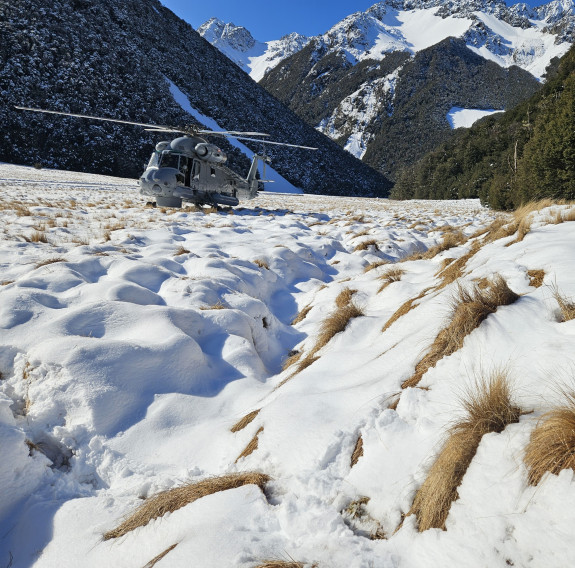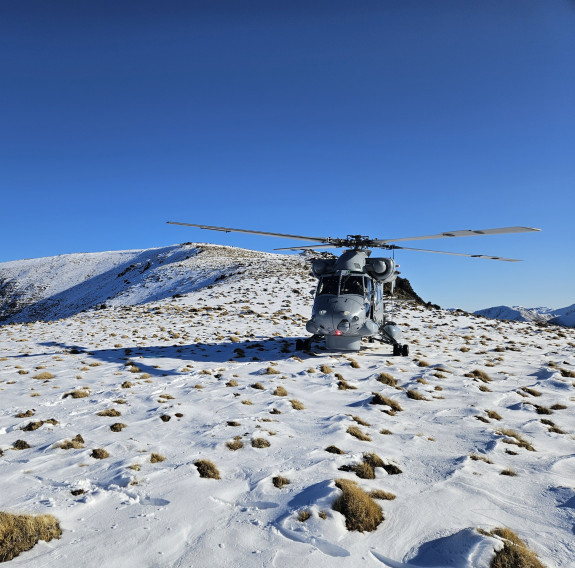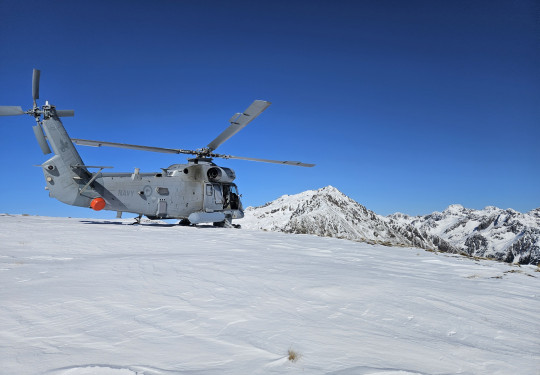No.6 Squadron multitasks during Exercise Bluebird
A Royal New Zealand Navy Seasprite deployment goes from mastering the peaks of Marlborough to scoping fishing activity near Nelson.
01 October, 2024
Mountain flying might seem an odd activity for a maritime pilot and crew, but it’s a vital skill for helicopter aircrew in No. 6 Squadron.
In August, positioned in the Royal New Zealand Air Force’s (RNZAF) Dip Flat training camp in the Wairau Valley, Marlborough, flight crews in two Seasprite SH2-G(I) helicopters honed the techniques and skills needed to fly in and around Marlborough’s mountain ranges.
Exercise Bluebird is an annual exercise, designed to introduce new aircrew to a mountainous environment, and keep experienced aircrew current. The Air Force conducts Exercise Blackbird, a similar exercise using NH-90s, in the same location.
Mountains create unpredictable flying conditions. Thinner, colder air affects a helicopter’s power and performance. Pilots are likely to encounter unexpected wind directions depending on whether they’re near a valley, bowl, pinnacle or ridge.
The skills are necessary because maritime aircrew will encounter dramatic terrain in their careers, including missions to the sub-Antarctic islands, Kermedec Islands and volcanic Pacific Islands.


Tasking Officer Sub Lieutenant Angus Graves, who comes from Nelson, says two observers and one loadmaster got their first qualifications, while 12 other personnel regained currency.
“The first week was amazing. When we arrived, there had just been this big dump of snow and was super-cold. But the first days were stunning, really clear. We got both helicopters up and achieved a huge amount."
"The following week the weather wasn’t great.”
While in the neighbourhood, the squadron assisted Ministry for Primary Industries (MPI) in a fisheries tasking in the Marlborough Sounds and Tasman Bay.
“Flexibility is the key to air power,” says SLT Graves.
“We asked MPI if there were any taskings we could do. We put a helicopter on patrol around D’Urville Island and Tasman Bay, with a focus on amateur charter vessel operators.
“When those boats go out, there’s various things they say they’ll do, and we’re checking to see if that’s what they were doing.”
According to MPI, amateur charter vessel operators are paid for providing a vessel and guide services for recreational fishers. They are required to register with Fisheries New Zealand and must report what is caught on their fishing trips.
Steve Ham, Director of Fisheries Compliance at MPI, says the collaboration is invaluable.
“From time to time Fisheries New Zealand will utilise the air or sea assets of the New Zealand Defence Force for fisheries compliance patrols. We view this joint agency approach as essential to ensuring rules and regulations are being followed, and we appreciate the cooperation we enjoy with NZDF in keeping our shared fisheries sustainable.”
The Squadron was due to do school visits in Nelson, but the weather became too difficult.
“Overall we flew about 56 hours across the two weeks, so we got a good amount in and did everything we wanted to achieve, except the school visits.”
“Exercise Bluebird is definitely a highlight for us. A lot of work goes into it, moving the Squadron down to RNZAF Base Woodbourne, but it’s good living together and the Base mess hosts us. It’s great for team building, and you get to see a lot of beautiful mountains.”
